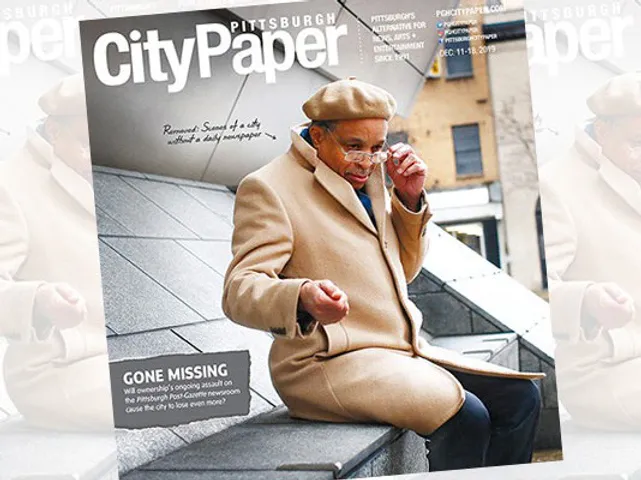
Cover Photo for Pittsburgh City Paper on December 17th 2019.
For the last 28 days, bylines were noticeably absent from the Pittsburgh Post-Gazette (PG). Nearly every single article, photo and graphic that was published in the paper lacked attribution. While the news content produced during this time remained the same—with stellar reporting and reliable coverage—readers had absolutely no idea which reporter had written the story they were reading.
A lack of bylines was part of a concerted strategy led by the Newspaper Guild of Pittsburgh, the union that represents the journalists working at the PG. The Guild dubbed it a “byline strike” and issued a “no confidence” vote against the paper’s management in mid-November. A lack of bylines was a visual representation that showed reporters are the lifeline of the paper.
So, what led to the byline strike? Suffice to say, the last few months (and even years) have been chaotic and tumultuous for the reporters working at the PG. Here’s a brief summary of what the members of the Guild have been dealing with:
Reporters haven’t had a raise in over a decade;
They’ve been working without a contract for nearly three years;
There have been major editorial content disputes between reporters and management;
Longtime news editors have either left or were fired;
Several reporters have being assigned new beats with little explanation;
Due to the changing media landscape, the PG’s is only printed 3 times per week;
And, earlier this year, there was a public outburst that occurred in the middle of the newsroom late on a Saturday evening involving John Robinson Block, the publisher of the paper.
As a result of these issues and many more swirling behind the scenes, the Guild issued a statement saying that its members took the “unprecedented act of voting no confidence in PG Executive Editor Keith Burris, Publisher John Robinson Block, and newspaper owner Block Communications (BCI) for their escalating unconscionable treatment of employees, union members, and managers alike”.
Additionally the Guild’s statement said that the editor and the Blocks “have declared an unprecedented scorched-earth war on their employees and the culture of the PG newsroom.” Furthermore, their statement said, management “created a culture of fear, hostility and intimidation in the newsroom…and have transformed a previously collegial, pleasant and enjoyable workplace — one conducive to Guild members fulfilling our journalistic calling — into a tense, toxic environment, bereft of joy and respect.”
Reading the Guild’s statement a few weeks ago was shocking. As someone who majored in journalism, is a self-confessed news addict, and has the utmost respect for reporters, it was heartbreaking to read in full detail what the PG’s reporters have been dealing with. These kinds of stories and allegations about systematic employee maltreatment are generally found in the political and corporate realms—not in a newsroom. Especially, this is not what you’d expect from a paper that recently won a Pulitzer Prize for its outstanding coverage of the Tree of Life Synagogue massacre.
As a statewide public relations and issue advocacy firm, we at Ceisler Media often interact with reporters at the PG for on many issues. Sometimes we are proactively pitching stories on behalf of our clients; other times reporters reach out to us for background information or to speak to one of our clients who can serve as a subject matter expert for a particular story that they are working on.
While we maintain a friendly working relationship with PG reporters and many others across the state and beyond, we know full-well that reporters’ jobs require them to be naturally antagonistic. Some may think that reporters are aggressive or hostile, but that is not true. A reporter’s job is to research, ask questions (often, very tough, hard-hitting questions), talk to sources, gather the facts, and report those facts through an objective lens. Sometimes, the facts may not paint a flattering picture of an issue or person, but that doesn’t make the facts any less true.
Toward that end, the Guild was faced with a predicament of its own. How can it present the facts, yet advocate for its membership? Traditionally, journalists report the facts and they don’t advocate for a particular side of an issue. So, it was fascinating to watch how the Guild disseminated information pertaining to its cause, while also advocating for its people.
The Guild created and executed its own public awareness campaign. The reporters of the Guild not only withheld their bylines, they took their cause and grievances to social media. The Guild issued a call to action. It began encouraging the public to complain to the paper’s editor and publisher and provided ways that members of the public could contact them (the Guild tweeted out their email addresses). The Guild also created its own hashtags which began trending (#noPGwithoutME #NoConfidence), and conducted a leafleting outside of an event at Heinz Field that was sponsored by the paper. Other local media outlets, most notably the Pittsburgh City Paper, the Pittsburgh Current, Tribune Review, and WESA-FM helped to amplify the Guild’s efforts by continually covering the byline strike as a news story.
The Guild ended the byline strike on Dec. 17—nearly a month after it started. But did it work? Guild president and longtime PG reporter Michael Fuoco said in a press release that they believe the strike was successful because it raised public awareness about the plight the reporters are facing.
In an era where journalists are slammed and the media is constantly being labeled as fake news, it’s important—now more than ever before—for all of us to pay closer attention to what is happening behind the scenes to the outlets that provide us with news. Without reporters to cover events and issues that impact our local communities, how can the public be expected to get the facts and for matters of corruption to be exposed?
While I would agree that the byline strike worked and elevated the cause in the public square, I will be patiently waiting to see if it was enough for the publisher, editor, and the Guild to find common ground. For the sake of our region and the long-term future of the PG, I hope it was enough.
Only time will tell.




